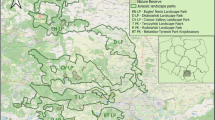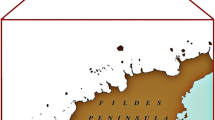Abstract
In this paper, the behaviour and distribution patterns of heavy hydrocarbons and several polycyclic aromatic hydrocarbon (PAH) priority pollutants, as listed by the US Environmental Protection Agency, were evaluated in 891 soil samples. The samples were collected in three expected polluted rural sites in Campania (southern Italy) as part of the LIFE11 ECOREMED project, funded by the European Commission, to test innovative agriculture-based soil restoration techniques. These sites have been selected because they have been used for the temporary storage of urban and building waste (Teverola), subject to illicit dumping of unknown material (Trentola-Ducenta), or suspected to be polluted by metals due to agricultural practices (Giugliano). Chemical analysis of soil samples allowed the baseline pollution levels to be determined prior to any intervention. It was found that these areas can be considered contaminated for residential use, in accordance with Italian environmental law (Law Decree 152/2006). Statistical analysis applied to the data proved that average mean concentrations of heavy hydrocarbons could be as high as 140 mg/kg of dry soil with peaks of 700 mg/kg of dry soil, for the Trentola-Ducenta site; the median concentration of analytical results for hydrocarbon (HC) concentration for the Trentola-Ducenta and Giugliano sites was 63 and 73.4 mg/kg dry soil, respectively; for Teverola, the median level was 35 mg/kg dry soil. Some PAHs (usually benzo(a)pyrene) also exceeded the maximum allowed level in all sites. From the principal component analysis applied to PAH concentrations, it emerged that pollutants can be supposed to derive from a single source for the three sites. Diagnostic ratios calculated to determine possible PAH sources suggest petroleum combustion or disposal practice. Our sampling protocol also showed large dishomogeneity in soil pollutant spatial distribution, even at a scale as small as 3.3 m, indicating that variability could emerge at very short spatial scales.




Similar content being viewed by others
References
AIRTUM (2014) Associazione Italiana dei Registri TUMori. The ITACAN database. http://www.registri-tumori.it. Accessed 1 April 2015
Albanese S, Lima A, De Vivo B, Cicchella D (2007) Atlante geochimico-ambientale dei suoli del territorio comunale di Avellino/Geochemical environmental atlas of the soils of Avellino. Aracne Editrice, Roma
Albanese S, Cicchella D, Lima A, De Vivo B (2008) Urban geochemical mapping. In: Environmental geochemistry: site characterization, data analysis and case histories. Elsevier, Amsterdam, pp 153–174
Albanese S, Fontaine B, Chen W, Lima A, Cannatelli C, Piccolo A, Qi S, Wang M, De Vivo B (2014) Polycyclic aromatic hydrocarbons in the soils of a densely populated region and associated human health risks: the Campania plain (Southern Italy) case study. Environ Geochem Health 37:1–20
Balestri G (2010) Consulenza Tecnica nei luoghi di cui al decreto di sequestro probatorio del 17/07/08 e segg. nelle Località: Masseria del Pozzo, Schiavi e San Giuseppiello in Giugliano in Campania; terreni in SP Trentola-Ischitella in Trentola e in Torre di Pacifico in Lusciano e siti non sequestrati in Castel Volturno o oggetto di precedenti sequestri in loc. Scafarea (Giugliano). Technical report to the Public Prosecutor at the Court of Naples. http://corrieredelmezzogiorno.corriere.it/campania/media/fissi/pdf/balestri.pdf. Accessed 1 April 2015
Bergvall C, Westerholm R (2007) Identification and determination of highly carcinogenic dibenzopyrene isomers in air particulate samples from a street canyon, a rooftop, and a subway station in Stockholm. Environ Sci Technol 41:731–737
Boudreault JP, Dubé JS, Sona M, Hardy E (2012) Analysis of procedures for sampling contaminated soil using Gy’s Sampling Theory and Practice. Sci Total Environ 425:199–207
Caricchia AM, Chiavarini S, Pezza M (1999) Polycyclic aromatic hydrocarbons in the urban atmospheric particulate matter in the city of Naples (Italy). Atmos Environ 33:3731–3738
Carter MR, Gregorich EG (2008) Soil sampling and methods of analysis. CRC Press, Boca Raton
Cattell RB (1966) The scree test for the number of factors. Multivar Behav Res 1:245–276
D’Alisa G, Burgalassi D, Healy H, Walter M (2010) Conflict in Campania: waste emergency or crisis of democracy. Ecol Econ 70:239–249
De Felip E, Bianchi F, Bove C, Cori L, D’Argenzio A, D’Orsi G, Fusco M, Miniero R, Ortolani R, Palombino R et al (2014) Priority persistent contaminants in people dwelling in critical areas of Campania Region, Italy (SE-BIOREC biomonitoring study). Sci Total Environ 487:420–435
De Nicola F, Alfani A, Maisto G (2014) Polycyclic aromatic hydrocarbon contamination in an urban area assessed by Quercus ilex leaves and soil. Environ Sci Pollut Res 21:7616–7623
Dvorská A, Lammel G, Klánová J (2011) Use of diagnostic ratios for studying source apportionment and reactivity of ambient polycyclic aromatic hydrocarbons over Central Europe. Atmos Environ 45:420–427
ECOREMED (2014) http://www.ecoremed.it/. Accessed 1 April 2015
Efron B (1979) Bootstrap methods: another look at the jackknife. Ann Stat 79:1–26
Efron B, Tibshirani RJ (1994) An introduction to the bootstrap, vol 57 of Monographs on Statistics and Applied Probability. Chapman and Hall, New York
Esposito M, Serpe FP, Neugebauer F, Cavallo S, Gallo P, Colarusso G, Baldi L, Iovane G, Serpe L (2010) Contamination levels and congener distribution of PCDDs, PCDFs and dioxin-like PCBs in buffalos milk from Caserta province (Italy). Chemosphere 79:341–348
European Environment Agency (2014) Raster data on land cover for the CLC2000 inventory. Office for Official Publications of the European Communities
Eurostat (2011) Generation and treatment of waste in Europe 2008. Tech. Rep. 44, Environmental Data Centre on Waste, Germany
Fabietti G, Biasioli M, Barberis R, Ajmone-Marsan F (2010) Soil contamination by organic and inorganic pollutants at the regional scale: the case of Piedmont, Italy. J Soils Sediments 10:290–300
Fedele L, De Vivo B, Lima A, Albanese S, Cicchella D, Grezzi G (2008) Atlante geochimico-ambientale dei suoli del territorio comunale di Salerno/Geochemical environmental atlas of the soils of Salerno. Aracne Editrice, Rome
Fent K (2004) Ecotoxicological effects at contaminated sites. Toxicology 205:223–240
Giovannini A, Rivezzi G, Carideo P, Ceci R, Diletti G, Ippoliti C, Migliorati G, Piscitelli P, Ripani A, Salini R et al (2014) Dioxins levels in breast milk of women living in Caserta and Naples: assessment of environmental risk factors. Chemosphere 94:76–84
Horn JL (1965) A rationale and test for the number of factors in factor analysis. Psychometrika 30:179–185
IARC Working Group (2010) Some non-heterocyclic polycyclic aromatic hydrocarbons and some related exposures. IARC monographs on the evaluation of carcinogenic risks to humans. World Health Organization, International Agency for Research on Cancer, France. 92:858
Jolliffe I (2005) Principal component analysis. Wiley, Chichester
Kozielska B, Konieczyński J (2015) Polycyclic aromatic hydrocarbons in particulate matter emitted from coke oven battery. Fuel 144:327–334
Krumal K, Mikuska P, Vecera Z (2013) Polycyclic aromatic hydrocarbons and hopanes in PM1 aerosols in urban areas. Atmos Environ 67:27–37
Latimer JS, Zheng J (2003) Sources, transport, and fate of PAHs in the marine environment. In: Douben PET (ed) PAHs: an ecotoxicological perspective. Wiley, Chichester, pp 9–23
Ledesma RD, Valero-Mora P (2007) Determining the number of factors to retain in EFA: an easy-to-use computer program for carrying out parallel analysis. Pract Assess Res Eval 12:1–11
Mai BX, Fu JM, Sheng GY, Kang YH, Lin Z, Zhang G, Min YS, Zeng EY (2002) Chlorinated and polycyclic aromatic hydrocarbons in riverine and estuarine sediments from Pearl River Delta, China. Environ Pollut 117:457–474
Malcolm HM, Dobson S (1994) The calculation of an environmental assessment level (EAL) for atmospheric PAHs using relative potencies. Tech. Rep. DoE/HMIP/RR/94/041. Department of the Environment, Her Majesty’s Inspectorate of Pollution, Great Britain
Máthé I, Benedek T, Táncsics A, Palatinszky M, Lányi S, Márialigeti K (2012) Diversity, activity, antibiotic and heavy metal resistance of bacteria from petroleum hydrocarbon contaminated soils located in Harghita County (Romania). Int Biodeterior Biodegrad 73:41–49
Nature (2014) A toxic legacy. Editorial 508:431–432
Nisbet IC, LaGoy PK (1992) Toxic equivalency factors (TEFs) for polycyclic aromatic hydrocarbons (PAHs). Regul Toxicol Pharmacol 16:290–300
Orecchio S (2010) Assessment of polycyclic aromatic hydrocarbons (PAHs) in soil of a Natural Reserve (Isola delle Femmine, Italy) located in front of a plant for the production of cement. J Hazard Mater 173:358–368
Panagos P, Van Liedekerke M, Yigini Y, Montanarella L (2013) Contaminated sites in Europe: review of the current situation based on data collected through a European network. J Environ Public Health 2013, 158764. doi:10.1155/2013/158764
Rushton L (2003) Health hazards and waste management. Br Med Bull 68:183–197
Schwartz G, Ben-Dor E, Eshel G (2012) Quantitative analysis of total petroleum hydrocarbons in soils: comparison between reflectance spectroscopy and solvent extraction by 3 certified laboratories. Appl Environ Soil Sci 2012, 751956. doi:10.1155/2012/751956
Senior K, Mazza A (2004) Italian “triangle of death” linked to waste crisis. Lancet Oncol 5(9):525–527
Theocharopoulos S, Wagner G, Sprengart J, Mohr ME, Desaules A, Muntau H, Christou M, Quevauviller P (2001) European soil sampling guidelines for soil pollution studies. Sci Total Environ 264:51–62
UNI EN ISO 16703 (2011) Soil quality—determination of content of hydrocarbon in the range C10 to C40 by gas chromatography. European Standard. UNI Printing Office, Milan, Italy
US-EPA Method 8270 (2007) Semivolatile organic compounds by gas chromatography/mass spectrometry (GC/MS). United States Environmental Protection Agency, SW-846 manual. US Government Printing Office, Washington, DC
US-EPA Method 8440 (1996) Total recoverable petroleum hydrocarbons by infrared spectrophotometry. United States Environmental Protection Agency, SW-846 manual. US Government Printing Office, Washington, DC
Vito M (2008) Siti Contaminati in Campania. Tech. Rep., ARPAC-Servizio Comunicazione, Informazione, Educazione, URP, Italy
Wang Z, Fingas MF (2003) Development of oil hydrocarbon fingerprinting and identification techniques. Mar Pollut Bull 47:423–452
Wilcke W (2000) Synopsis polycyclic aromatic hydrocarbons (PAHs) in soil—a review. J Plant Nutr Soil Sci 163:229–248
Yan J, Wang L, Fu PP, Yu H (2004) Photomutagenicity of 16 polycyclic aromatic hydrocarbons from the US EPA priority pollutant list. Mutat Res Genet Toxicol Environ Mutagen 557:99–108
Yunker MB, MacDonald RW, Vingarzan R, Mitchell RH, Goyette D, Sylvestre S (2002) PAHs in the Fraser River basin: a critical appraisal of PAH ratios as indicators of PAH source and composition. Org Geochem 33:489–515
Zampella M, Adamo P, Caner L, Righi SP, Terribile F (2010) Chromium and copper in micromorphological features and clay fractions of volcanic soils with andic properties. Geoderma 157(3–4):185–195
Acknowledgments
This paper gives part of the results of the action C1 of the LIFE+ project LIFE11/ENV/IT/275 ECOREMED: Implementation of eco-compatible protocols for agricultural soil remediation in Litorale Domizio-Agro Aversano NIPS launched in 2012 (Coordinator Prof. M. Fagnano).
We wish to thank the staff of Naples Federico II University Lorenzo Boccia and Stefania Pindozzi for georeferencing sampling points; Mauro Mori and his research group for soil sampling; and the staff of Naples Federico II University and ARPAC Ida Duro, Claudia Rocco, Angela Vetromile, Maria Di Rosa and Mariano Peri for helping in analytical activity.
Author information
Authors and Affiliations
Corresponding author
Additional information
Responsible editor: Hongwen Sun
Rights and permissions
About this article
Cite this article
Monaco, D., Riccio, A., Chianese, E. et al. Chemical characterization and spatial distribution of PAHs and heavy hydrocarbons in rural sites of Campania Region, South Italy. Environ Sci Pollut Res 22, 14993–15003 (2015). https://doi.org/10.1007/s11356-015-4733-y
Received:
Accepted:
Published:
Issue Date:
DOI: https://doi.org/10.1007/s11356-015-4733-y




